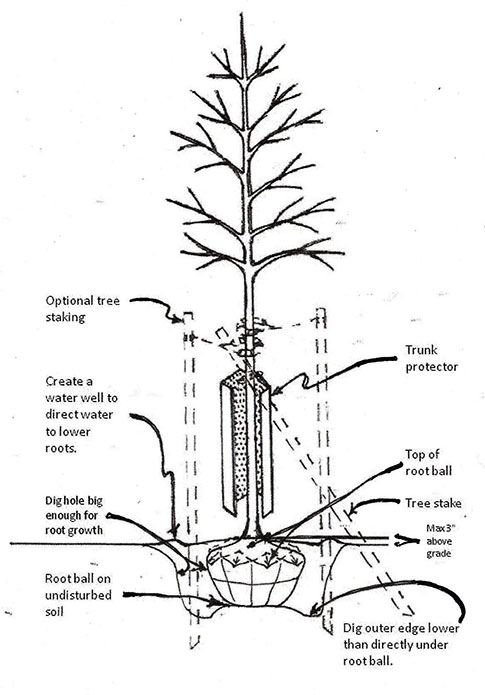Once you are ready to plant your new tree…
- Dig a hole that is respectfully wider than the root ball. *Note, that some areas restrict the size of the hole you can dig so make sure to have measurements ready when purchasing a tree or any other plant material. A wider hole will allow the roots to easily penetrate the surrounding soils and establish themselves. Try not to dig the hole any deeper than the root ball. It is usually best to set the root ball on undisturbed soil (see adjacent diagram).

- Your tree should be planted 1 to 3 inches above ground level rather than too deep. This insures your tree will be able to breath and have adequate oxygen for the root system even if you do not have well-drained soil.Before placing your tree in the hole, measure again and verify the hole is dug to the correct depth. It is difficult to take your tree back out of the hole without damaging the root ball or yourself.
- If your tree requires well-drained soil, a simple way to check your soil is to dig a foot deep hole and fill it with water. In about 12 hours, check to see if the water has perked into the soil. If the water hasn’t absorbed completely and has perked less than an inch per hour, you have a serious drainage problem. It may be necessary to build a mound and plant your tree a little higher than the surrounding ground elevation to compensate for drainage.Fill the bottom of the hole with a few inches of water and place the tree in the hole. Position and straighten your tree as you backfill carefully around the ball, using the best of the soil you removed when digging the hole. Once your tree is stable, cut and remove the top 1/3 of the rope and burlap off of the trees root ball.It is not necessary to remove the wire basket and burlap from the bottom of the root ball. The burlap will decompose over time and the basket will actually provide trace elements of iron as it rusts. You can also blend in organic matter into the soil you will be using around the root ball. It will provide natural nutrients for the tree over the next few years.Continue filling the hole, tamping and eliminating any large air pockets around the root ball. Try not to stomp around the tree since roots require oxygen in order to grow and develop properly. Water slowly once you are done planting the tree. The water will naturally settle the soil around the root ball and give your tree adequate moisture for about a week.
- Avoid Staking Unless NecessaryMost of Victory Greens balled and burlapped trees have a substantial root ball and if properly planted will not require staking. Even in most of our typical windstorms, the movement of the trunk will actually aid in the development of a stronger root system.If you are planting in an extremely windy area with no protection, it may be necessary to stake your tree. There are several methods of staking that can be utilized for stabilizing your tree for the first year. A popular method is a single stake on an angle (see adjacent diagram) propping the tree toward the prevailing winds. Aiming the stake to the northwest in Boise Valley will usually be more than adequate.Once you have planted your tree, it is best to form a circular dam of soil around your tree. This will create a water-well that will allow you to slowly soak your tree and give it a deep drink without having the water run away.Use Fertilome Root Stimulator to soil drench and aid your new tree’s root growth. Apply a half-gallon of mixed root stimulator per caliper inch. Do not fertilize your tree during the first growing season. You could burn the tender feeder roots with too much nitrogen and actually do more damage than benefit.
- Weekly watering will be adequate unless it is extremely hot and dry. Your tree will re-establish much quicker with less moisture rather than if it is over-watered and in wet heavy clay-soil that will prohibit it from getting needed oxygen.Consider investing roughly ten dollars in a moisture meter from one of the home improvement stores. It will help tell you when to give your tree water. If the meter shows dry, add water. If the meter shows saturated, hold off!Also, by paying attention to your tree’s body language you will learn when your tree is happy and growing well. You will also recognize when it is struggling and looking poorly. Remember 90% of all trees that die in the first year, die from overwatering.
If you have any questions about buying, planting or watering trees in the Boise area, feel free to call our nursery at (208) 888-5551
